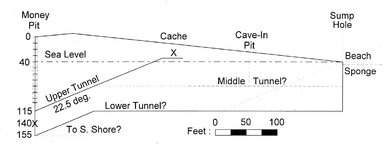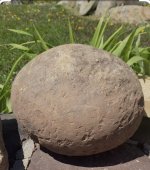gjb
Full Member
- Apr 21, 2016
- 240
- 307
- Detector(s) used
-
Garrett Ace 300i
Garrett EuroAce
- Primary Interest:
- All Treasure Hunting
I wonder if it’s generally appreciated that assumptions concerning the Money Pit might indicate a date range for the undertaking.
Maybe we talk too glibly about there having been a water trap at the Money Pit, and that this was a defensive measure. After all, the reason we fully understand the mechanics of such a trap is because we have 21st century educations, but, specifically, we understand this because our education is post-1700.
This means that depending on what you believe about the Money Pit, the originator’s education might also have to be post-1700, and the date of the operation would also have to be after this.
With respect to the assumed flood tunnel, then, it would be relevant to ask what the originator actually knew about air and water under pressure, rather than what would be merely assumed according to the Classical tradition.
This is to ask whether the originator’s knowledge was modern, that is, after the period 1650-1700, or if it was ancient, that is, prior to this?
For example, it’s assumed there was a flood tunnel at 110 feet, and a wooden ‘treasure’ platform at 104 feet. This means there was a gap of six feet in which air would be trapped when the water rose. What did the originator believe would happen to this air?
Did he know about air pressure?
Did he know that the trapped air would even be under pressure, and by how much, and by what proportion this volume of air might be reduced by that pressure?
Did he know whether the pressure would be equal in all directions, in effect, whether the water in a tunnel leading off the bottom of a shaft filled with water would even be under pressure?
Did he appreciate the effect that 60 feet of water in a Sump Hole, or a downward sloping flood tunnel, would have on the ‘plug’ in the Money Pit, and did he know whether the weight of the air above this column of water was relevant in his calculations, if he did any?
Would he have believed that the air between the top of the flood tunnel at 110 feet and the platform at 98 ft. (12 feet of air) would have prevented the water from rising above the assumed treasure platform in between, that is, at 104 feet, after being compressed?
Did he think that the platform would keep the water out? Did he not appreciate that wooden ships leak?
Did he think that the soil between the platforms would resist the rise of the water?
If there was a water trap, and the originator knew the answers to the above questions, then the date of the operation is after about 1680.
Would the originator have risked his treasure, not knowing the answers to these potential challenges, or did he just stumble on regardless of consequences? Or is this just one more facet of our assumption that there was water in the Money Pit when the originator left the island, or that he permitted water to get anywhere near his supposed treasure in the Money Pit?
If the originator truly knew what he was doing, if he was conversant with hydrostatics, then given water in the Money Pit we should probably date the operation from shortly before 1700 to shortly before its discovery.
However, if there was no water in the Money Pit, or the originator had no idea whatsoever what he was doing, then the question of technical know-how doesn't arise. Pick your own date!
Maybe we talk too glibly about there having been a water trap at the Money Pit, and that this was a defensive measure. After all, the reason we fully understand the mechanics of such a trap is because we have 21st century educations, but, specifically, we understand this because our education is post-1700.
This means that depending on what you believe about the Money Pit, the originator’s education might also have to be post-1700, and the date of the operation would also have to be after this.
With respect to the assumed flood tunnel, then, it would be relevant to ask what the originator actually knew about air and water under pressure, rather than what would be merely assumed according to the Classical tradition.
This is to ask whether the originator’s knowledge was modern, that is, after the period 1650-1700, or if it was ancient, that is, prior to this?
For example, it’s assumed there was a flood tunnel at 110 feet, and a wooden ‘treasure’ platform at 104 feet. This means there was a gap of six feet in which air would be trapped when the water rose. What did the originator believe would happen to this air?
Did he know about air pressure?
Did he know that the trapped air would even be under pressure, and by how much, and by what proportion this volume of air might be reduced by that pressure?
Did he know whether the pressure would be equal in all directions, in effect, whether the water in a tunnel leading off the bottom of a shaft filled with water would even be under pressure?
Did he appreciate the effect that 60 feet of water in a Sump Hole, or a downward sloping flood tunnel, would have on the ‘plug’ in the Money Pit, and did he know whether the weight of the air above this column of water was relevant in his calculations, if he did any?
Would he have believed that the air between the top of the flood tunnel at 110 feet and the platform at 98 ft. (12 feet of air) would have prevented the water from rising above the assumed treasure platform in between, that is, at 104 feet, after being compressed?
Did he think that the platform would keep the water out? Did he not appreciate that wooden ships leak?
Did he think that the soil between the platforms would resist the rise of the water?
If there was a water trap, and the originator knew the answers to the above questions, then the date of the operation is after about 1680.
Would the originator have risked his treasure, not knowing the answers to these potential challenges, or did he just stumble on regardless of consequences? Or is this just one more facet of our assumption that there was water in the Money Pit when the originator left the island, or that he permitted water to get anywhere near his supposed treasure in the Money Pit?
If the originator truly knew what he was doing, if he was conversant with hydrostatics, then given water in the Money Pit we should probably date the operation from shortly before 1700 to shortly before its discovery.
However, if there was no water in the Money Pit, or the originator had no idea whatsoever what he was doing, then the question of technical know-how doesn't arise. Pick your own date!
Last edited:


 on both.
on both.





